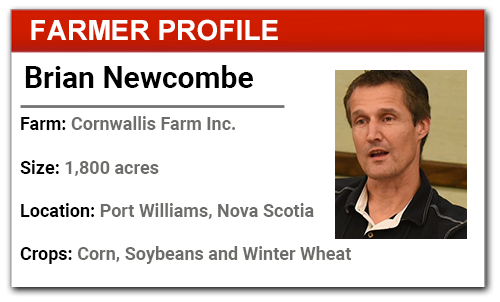
Brian Newcombe, who farms with his brother Craig, near Port Williams, Nova Scotia, has been incorporating precision farming techniques into their operation since 1998.
Over that time, they’ve gone to a predominantly no-till soybeans and wheat. The corn is strip-tilled, but during the last few years, Newcombe has experimented with planting directly into green cover crops.
For corn, they usually make the strip-till pass in the spring with a 12-row Dawn Pluribus rig, pulled by a John Deere 7830 tractor. They also have a Deere 6190R tractor ahead of a 12-row Kinze 3600 planter, outfitted with a Precision Planting 20/20 monitor and vSet seeding units. The planter also has a Delta Force hydraulic down pressure system and a Surefire Ag electric pump for section-controlled starter fertilizer placement through Totally Tubular fertilizer tubes.
The 7830 and the Deere 7520 planter tractor used Outback Guidance’s RTK auto- steer systems. “When we upgraded our planter tractor to a Deere 6190R, the Outback system was not compatible, so for the coming 2018 season, we had to change to Deere’s StarFire 6000 receivers,” Newcombe says. “We started with Outback’s auto-guidance system because we could easily install it into our older tractor’s hydraulic steering and didn’t have the high capital costs and annual signal fees of the Deere systems.”
For spraying and fertilizer application, the Newcombes use an Apache 1010 sprayer outfitted with a 90-foot boom and auto-height and section control, driven by a Raven Viper monitor following a WAAS signal.
“We also use a Trimble GreenSeeker system for nitrogen (N) application. It’s a little trickier for us because the algorithms it uses are developed for other areas such as Kansas and Oklahoma, so we need to adjust settings,” Newcombe says. “The system is easier for us to use in wheat than corn. In corn, the algorithms are designed for applying N at the V8 to V10 corn stage and with our smaller, odd-shaped fields it is more time consuming and we tend to run over more corn.”
They harvest with a Deere S660 combine that follows an SF1 signal. “That’s good enough for harvest and the corn head has row-crop fingers that keep it on the row,” Newcombe says.
They no-till winter wheat after soybeans in late September and October with a 30- foot Deere 1890 air seeder in 7½-inch row spacing. They seed 9-way cover crops after winter wheat harvest in August.
Point of Pain: Perfecting the Art of Map Making
Each year, Newcombe takes yield data from the combine and inputs it into Farm Works software to analyze the results and then build prescription maps for variable seeding rates on some fields to test the economic impact.
“It can be very time consuming,” he says. “I am the only one who does it, and most of our fields are 15 to 20 acres in size, so each field has to have its own map.”
The Newcombes apply 60 units per acre of 32% N with the strip-till rig, a straight rate of 5 gallons per acre of corn starter fertilizer and they topdress the remaining N with dry fertilizer.
“Our smaller fields take some time to set up for prescription rates,” Newcombe says. “It might not be as difficult if I did it every day or I had someone who could do it for me.”





